
Heather Hardie
3rd year, Art Education Specialization
Beaux language arts: A cross-curricular unit plan
Students create a collection of small-scale artworks for the purpose of collecting and trading with other students. The exchange is a holistic approach to education, encouraging sharing, and exchange of ideas, interests, cultures and aesthetic values.
This unit plan connects the visual arts to language arts through a series of cross-curricular art activities that explore grammar, poetry, prose, narrative, character studies and other elements of language. In each lesson, art is used to enrich learning through the development of visual and language art appreciation, as well as encouraging creativity and skill development. The unit plan is entitled Beaux language arts in order to accommodate bilingual environments in Canadian education. The unit plan consists of six lessons that are divided into two main sections: artist trading cards and comic books. Students will form a collection of artist trading cards to exchange with other students in the classroom and from other schools. For the comic books, students will build from a character sketch activity to develop rich and interesting characters to compliment the narrative. In addition, students will complete five planning worksheets relating to the narrative elements, which include dialogue, setting, plot, conflict, and resolution. This unit plan intends to demonstrate a holistic approach to education, encouraging sharing, and exchange of ideas, interests, cultures and aesthetic values. I have used this unit plan at the fourth grade level. An example of a lesson plan is included in this unit plan.
Lesson one
Artist trading cards: Mixed media character sketch
Students will select a character from a novel, television show or film, as the source material for a character sketch worksheet. The worksheet requires students to analyze, break down and identify the elements that build their selected character. Working from the information gathered from the character sketch activity, students will create one or more artist trading cards using a variety of media and textures. The trading cards will be stored in plastic zipper bags to begin students’ personal collections, and will be exchanged later with students at other schools.

Lesson two
Artist trading cards: Secret codes and visual patterns
The second variation of the artist trading card project requires students to create a ‘visual code’ using random sets of letters, numbers and symbols. This code will be repeated on the trading cards using a student-drawn grid. Students will use this activity as a mode of translating one code into another, building skills that aid in language acquisition, and development of sensitivity to patterns in mathematics. The trading cards will be stored in students’ personal collections.
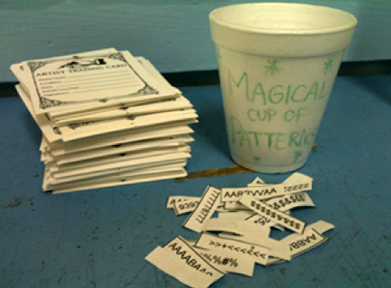
Lesson three
Artist trading cards: Barbara Kruger and Random poetry
Students will work in teams to organize small, pre-cut words into the following word categories: verbs, nouns, adjectives, adverbs, prepositions and pronouns. Each of these ‘word categories’ make up elements in a ‘word code’. For example, the sentence, The dog runs, includes a preposition, a noun, and a verb. Building upon the code-translating skills acquired from the previous lesson, students will create a ‘random poem’ by choosing random ‘word codes’ to assemble their sentences.
Using Barbara Kruger’s artwork as inspiration, students will explore the elements of visual composition, and consider how the placement of words on a given image works to create meaning in their artwork. Barbara Kruger is an American conceptual artist whose art practice often involves image and text collage as a commentary on consumer culture habits and values.
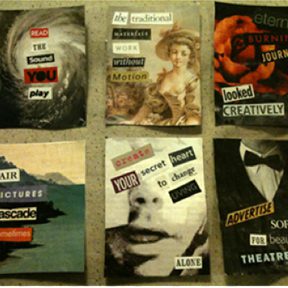
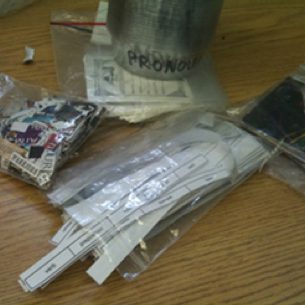
Lesson four
Comic books: Writing a story
Students will work in teams to compose and transform an original narrative into a comic book format. Students must organize and sequence the narrative so that the ‘flow’ and length correspond to the number of students in the group. For example, five students in a group must produce five pages. Each student is responsible for illustrating one page of the comic book.
Students will build on skills acquired from the character sketch activity to develop rich and interesting characters for their narrative. In addition, students will complete five planning worksheets relating to narrative elements, including dialogue, setting, plot, conflict, and resolution.
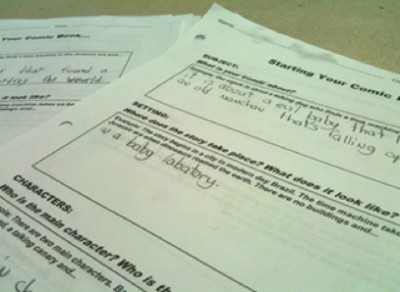
Lesson five
Comic books: Storyboarding
Students will be introduced to storyboarding as a tool for planning and translating written language into visual language. Students will work in teams, using storyboards to summarize, sequence and prepare their narratives as a rough yet constructive visual aid for the final comic book. Students will begin to plan their individual comic pages, working within their group to ensure cohesiveness of style, colour theme, and transitional elements in the comic book as a whole.
Students will work from examples of professional storyboards and will be introduced to relevant film terminology, which includes close up, extreme close up, medium shot, long shot, and extreme long shot.

Lesson six
Comic books: Illustrating
Each student will use their individual storyboard as a reference to illustrate one page in their group’s final comic book. Students will be provided with a variety of materials to create this project.
Artworks will be scanned and organized using the computer program Comic Life. Comic book elements such as panels, speech balloons and comic-style text (such as “POW!” or “sssss”) can be used to personalize and provide the comic with a professional appearance. Groups are reminded to maintain the unity of the project.
Finished comic books will be published online and shared with the class, family and friends. Students will respond to their own work and the work of others through reading and discussion.
Students respond to their own work and the work of others through reading and discussion.
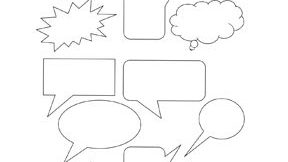

Lesson plan example
Artist trading cards: Barbara Kruger and random poetry
Students create a collection of small-scale artworks for the purpose of collecting and trading with other students. The exchange is a holistic approach to education, encouraging sharing, and exchange of ideas, interests, cultures and aesthetic values. By sharing with peers and students from other parts of Canada, students discover the similarities and differences between cultures and aesthetic predilection. By focusing on principles of grammar, this activity links visual arts to the language arts competencies in the MEQ.
Objectives
To engage students with small-format art forms.
To enrich students’ understanding of the English language by connecting language arts and
visual arts.
To encourage students to explore visual composition.
To connect with other students across Canada.
Time breakdown
Total lesson time: Approximately 1 hour
Total lesson time: Approximately 1 hour
Introduction and motivation: Approximately 15 minutes
Art making time: Approximately 20 minutes
Clean up time: Approximately 5 minutes
Response time and closure: Approximately 10-15 minutes
Required materials
Bristol board or card stock
Printer and photocopier
Magazines, newspapers (words and shapes pre-cut)
White glue
Scissors
Small plastic dishes
Laptop and projector or SmartBoard
Chalk board
Dictionaries (at least one per group)
Budget for materials
Only available materials and classroom resources will be used for this project. Paper, printers and photocopiers, laptop and SmartBoard, chalkboard and dictionaries are provided by the school. White glue and scissors are provided by students. Magazines, newspapers and small dishes are provided by donation. There should be no cost for this lesson.
Vocabulary
Modified list of vocabulary from Dictionary.com.
Noun – A person, place or thing; (boy, Canada, horse). Can you add “the” or “a” before the word? (Eg: a horse, the horse)
Verb – An action, or something you do; (walk, eat, sneeze). Can you add “to” before the word? (Eg: to walk, to eat, to sneeze)
Adjective – A describing word; (hairy, loud, annoying).
Adverb – A word that describes an action (verb); (quietly, quickly, carefully). Often ends in “ly”.(Eg. He walked quickly.)
Pronoun – Replaces a noun; (He, she, it, they). (Eg. The dog sniffed the shoe could also be: He sniffed the shoe / It sniffed the shoe.)
Preposition – Links two words together. (Eg: Eat the ham. It was raining cats and dogs.) Common mistakes include “is, are, be” – Just because they are small words does not mean they are prepositions!
Composition – The way your picture is organized or arranged. Where are the objects placed? How do they relate to the background?
Symmetry – A way of making things look balanced or even. Shapes or lines are the same on both sides of an imaginary central line (whether horizontal or vertical).
Asymmetry – The opposite of symmetry: When shapes or lines are not balanced or look even, but are not mirror image. (E.g. a large shape on one side of a work can create asymmetry with two small shapes on the other side of the work.)
Space – Something to think about when arranging your composition. How much space is there? How can we use the space?
Provisions for diverse learners
Learners with fine motor difficulties in cutting and drawing are provided with pre-cut materials.
Learners who have difficulty in categorization are placed in teams of varied abilities. Students have the opportunity to work together to solve problems that may arise. The instructor is available for questions.
To clarify the lesson’s objectives, concrete examples are shown on the projector, on the chalkboard and in a physical format of prototypes. Students who finish early may create extra cards, or challenge themselves by creating word codes for other students to translate.
Classroom management plan
Careful timing and sequencing (instructions before materials).
Teaching using proximity and moving around the classroom.
Reminders of time left (“if you are at this point, you should be…”).
Bring noise level down using a clapping system.
Resources
The class will be shown slides of Barbara Kruger’s artwork to discuss the relationship between text and meaning in a piece of art. Kruger’s use of text will be used as an example to open discussion on how the students might incorporate text in their art project. Examples of pre-made artist trading cards will be shown using the random poetry ‘formula’ to help students visualize the lesson objectives.
Rationale for lesson sequencing
This is the last of the artist trading card lessons. After executing other lessons with my students, I noticed that some were intimidated by drawing and almost all loved making collages. As a result, I felt this lesson would be a fun and an accessible project for everyone.
By placing this project after the previous lesson on visual codes, I felt that the concept of following a ‘word code’ on a slip of paper would make sense to them. The students learnt to follow the code sequence to determine which words to use from the sorted cups. These students also worked well with structure and set steps for completing an activity, so I placed the creative element into how they arranged the words on their background.
Assessment
Student assessment rubric:
As this was a two-part lesson, I assessed my students on two separate yet intersecting criteria: language arts and visual art. As a result, some students were stronger in one area while others excelled in both. By describing these criteria as intersecting, I intended and expected the two areas of learning to compliment each other, which in many cases did. Through observation, I noticed that the tactile and visually appealing nature of the cut-out words motivated the learners to move the words around, play with sentences and think about word properties.
My method of assessment was open and simple. I created a rubric that could be adapted for other similar projects by adding or altering specific criteria. Students were graded on seven categories – some, such as “uses information to meet lesson objectives” and “shows engagement through effort and participation” carried more weight than others (and were worth double marks) for a maximum of 10/10. Beside the seven grading criteria were three columns entitled, “Meets”, “Somewhat meets” and “Does not meet”, under which I could place a check mark. Each column was worth a certain number of points; for example, “Meets” was worth 1 point; “Somewhat meets” was worth .5 points; “Does not meet” was worth 0 points.
The main objective in this lesson was to demonstrate an understanding of word categories and properties through the sorting activity. Through observation, students were assessed on the identification of nouns, verbs, adjectives, prepositions, pronouns, and adverbs. The second objective was to create a composition using words and backgrounds, referencing the work of Barbara Kruger.
For a class of twenty-eight students, this was an effective and time efficient way of grading the assignment. Using a mark out of 10, the grade was easily translated into a percentage for the report cards. The adaptability of the rubric also allowed me to assess the multiples of the artist trading cards as one work as opposed to individual works.
Reflection on the lesson
What worked: Prior to carrying out the lesson, I cut words and backgrounds from an assortment of magazines, and prepared the sorting dishes, grammar slips and blank artist trading cards for the project. As I began directing the students to the materials, I quickly realized that this amount of preparation is necessary. Had I not prepared the materials in advance for the lesson, I would have been faced with countless challenges in terms of mess, questions surrounding which words to cut out and which images to use. Students had many options to choose from and I had extra magazines in case materials ran out.
The lesson lasted a little over an hour, however, the students would have continued working had they been given more time. Some students made up to fifteen cards each. This demonstrated that they enjoyed the process.
What didn’t. Frequently, the noise level was too loud and the class needed to be quieted. Regardless, I believe the level of noise is a good indicator of the excitement and engagement with the lesson. I also made the mistake of distributing the materials before finishing the explanation of the lesson, which caused disruption among some students.
The lesson was a challenging one. Some students understood the purpose and worked well sorting the words, while others tended to ‘shut off’. Instead of trying to figure out how to sort their words, these students just asked me or my cooperating teacher what the words were, one after another. I think that this was the result of the grouping of students. One of the reasons they were grouped was to help each other, but one or two of the groups lacked a strong student to help those who struggled with grammar concepts. I would pay closer attention to this need in my future lesson planning.
Overall achievements: Despite these feelings, the lesson came together successfully, and many of the students produced great work. The class helped to clean up, leaving time for an informal response. Together, we responded to the cards on a communal table. As this was the last lesson using the artist trading cards, I photographed all the cards and posted them on a class blog as a celebration of what they had created so far.
The resulting artwork was impressive, not just in terms of the amount produced, but the ways in which the text worked with the backgrounds to create meaning. It was evident that some students considered the placement of their words, which fulfilled the main requirement for this exercise. It is very satisfying to know that the lesson objectives were met, and to see the students enjoy themselves and take pride in their work.
References
Arbo, R. (2011). Artist trading cards. Family Fun Magazine. familyfun.go.com.
Dictionary.com, LLC. (2012). www.dictionary.com.
Gouvernement du Quebec. (2008). Progression of learning at the elementary level: English language arts. www.mels.gouv.qc.ca.
Gouvernement du Quebec. (2008). Progression of learning at the elementary level: Visual arts. www.mels.gouv.qc.ca.
Jacquelien. (2011). Artist trading cards. kidsartists.blogspot.com.
Meier, M. (2007). Artist trading cards. www.ucarts.com/atc.htm.
The Prairie Art Gallery. (2007). Children’s artist trading cards.prairiegallery.com.
Public Broadcasting Service (PBS). (2001). Art in the 21st century: Barbara Kruger. www.pbs.org